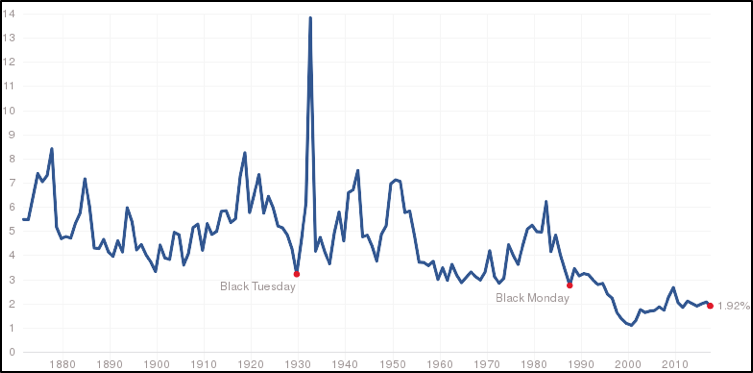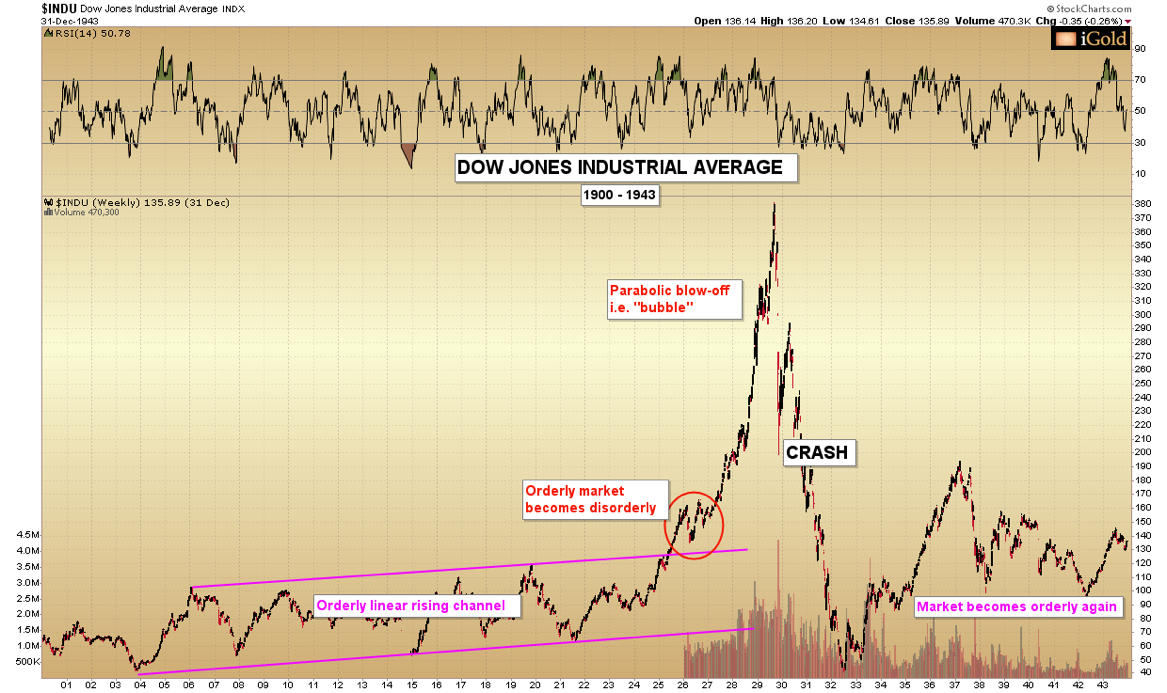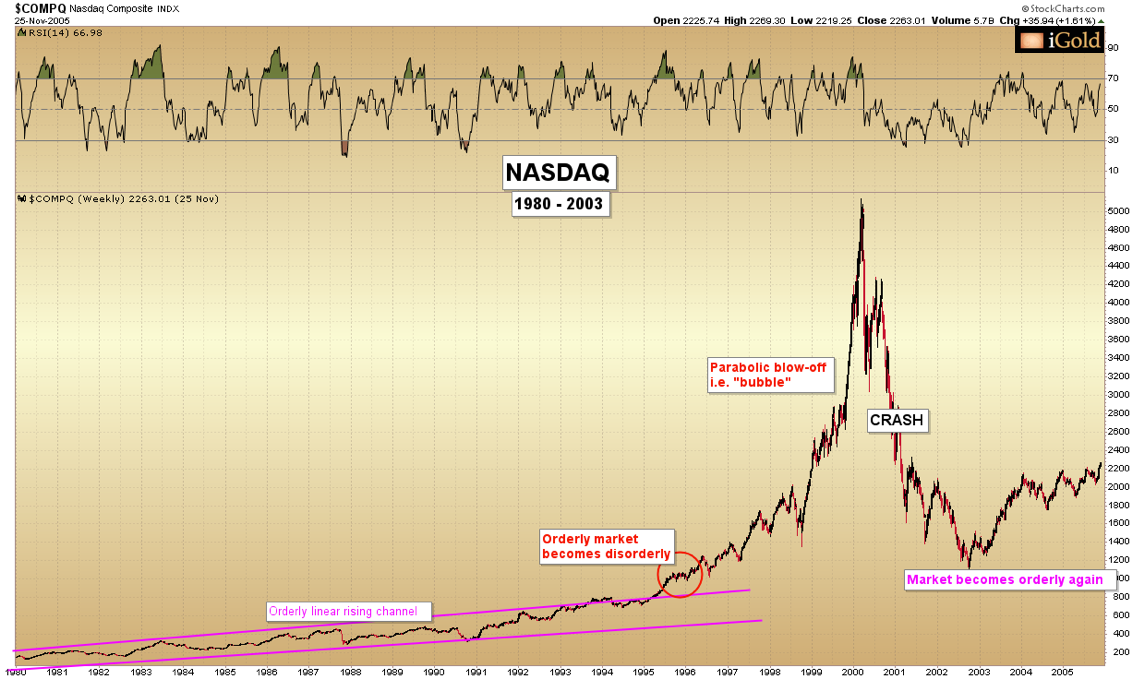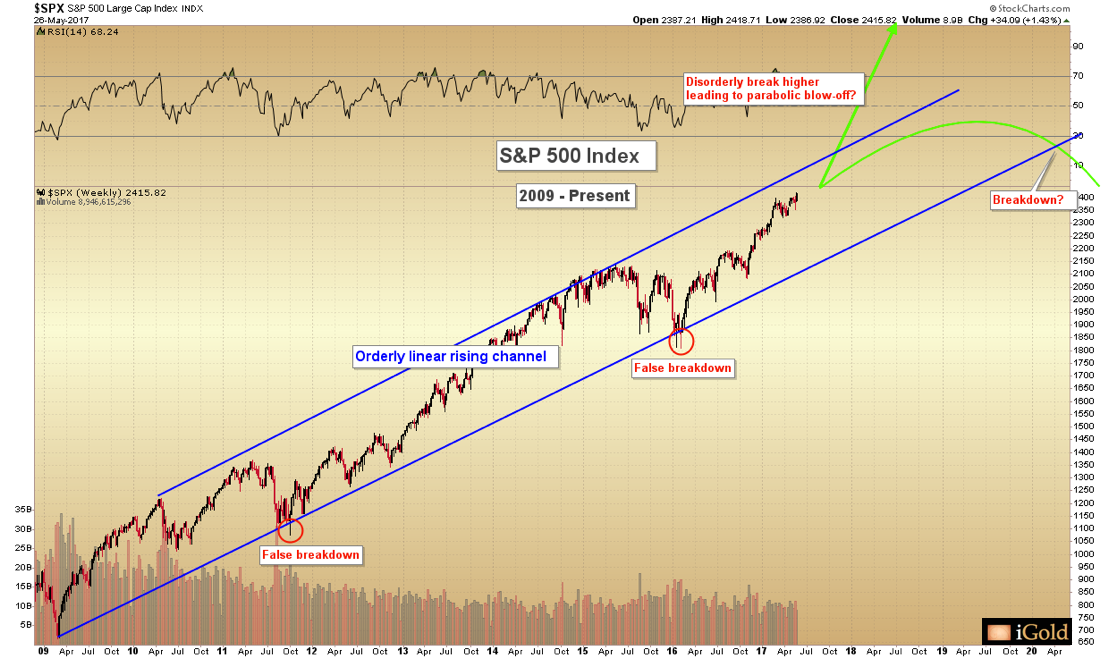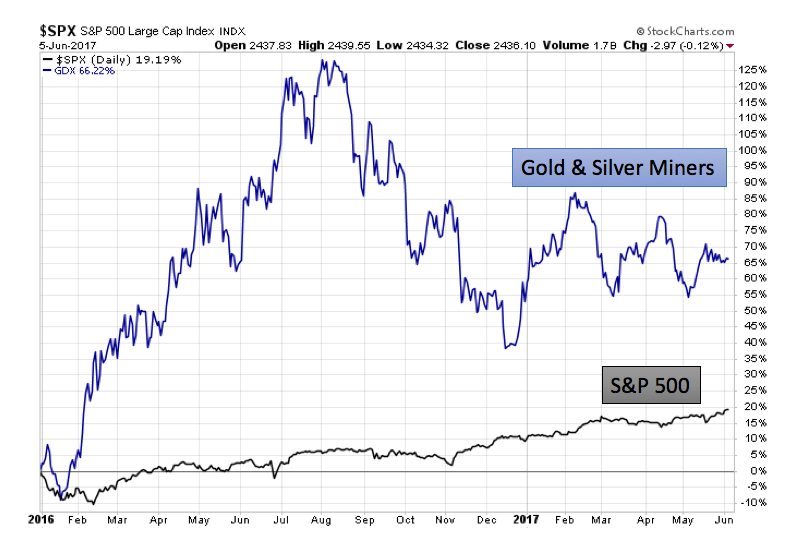US Stock Market – Signs Of A Top?
It seems that hardly a week goes by that we do not hear that the US stock market has hit another new all-time high. And indeed, the US capital markets have been amongst the best performers in the world since the crash of 2008-2009 lows.
Many have wondered when the US and world stock markets might reach a peak for the implication this trend reversal would have on the gold market. While not always the case, in general a falling stock market would cause certain investors to seek safety, and gold would be a primary beneficiary.
As a backdrop, we already know that dividend yields (i.e. shareholders’ income) are at hundred-year low levels. Dividend yields move inversely to price, so by this measure it appears that stock prices are largely overvalued.
For example, assuming companies could maintain dividend payments throughout a crash (however unlikely), it would take over a 60% crash in stock market prices to bring yields on the S&P 500 back to the 4.5% mean which held from the late 1800’s through 1990.
Further, yields are still below where they were during the peak of the 1929 bubble (labeled Black Tuesday)!
Yet we can also see that since 1995, investors have seemingly forgotten about yield altogether, as dividends have remained at 100+ year low levels for this entire period. Thus, we cannot use dividend yields alone as a predictor for the next stock market turndown, no matter how much lower than historic norms these payouts are.
We instead must turn to other forms of analysis.
Stock Market Tops From History – Crash Of 1929
There are specific technical characteristics of past market peaks that we can observe from history and apply to today. Let us look at a few examples.
First let us examine the period surrounding the great crash of 1929. Below is the chart of the Dow Jones Industrial Average from 1900 through 1943:
- From the early 1900’s through 1925, the US stock market was in a slow and steady bull market, defined by the orderly linear rising channel shown above (magenta lines). This coincided with a general increase in prosperity due to advances in technology, medicine, and standard of living, amidst low inflation on a gold standard. Orderly rising trends tend to define sustainable and healthy markets.
- In late 1925, this 25+ year rising channel was broken higher as speculative fervor began to take hold in the market (red circle). The orderly rising market had become disorderly. This was 12 years after the founding of the Federal Reserve, and this speculative period was largely a result of built-up money-printing from the Fed searching for an outlet.
- The disorderly advance preceded a parabolic frenzy, i.e. a “bubble” in the stock market.
- The bubble was followed by the Crash of 1929 as valuations had become unsustainable. The Dow Index lost over 90% during the next three years.
- After the crash and the washing out of the speculative excess, the Dow returned to an orderly rising trend for the next several decades.
Here we can gain key insight into the phases a market progresses through as it approaches an unsustainable bubble and the technical characteristics that define each stage.
- An orderly rising market.
- The market advance becomes disorderly.
- A parabolic rise.
- A crash.
- Return to an orderly market.
NASDAQ Bubble
We can see the same set technical characteristics when we study the NASDAQ / dot-com bubble of the 1990’s here in the United States:
Again, note the five stages that the market progressed through en route from an healthy rising market à to a disorderly advance à to a parabolic bubble à followed by a crash à followed by a return to some sense of order again.
These are key characteristics that we should look for in stock markets which are approaching speculative bubble peaks.
Not All Markets End In Parabolic Bubbles
We must remember that not all markets must feature parabolic blow-offs in their final stages. The other form that long-term tops may take is a rolling-over and breaking of the orderly rising channel to the downside, prior to a sustained decline.
An example of this setup was the bull market leading up to the Crash of 2008, shown below:
Here we see the same orderly linear rising channel to begin the bull market (blue channel).
However, in contrast to the two examples above, in 2007 we witnessed no disorderly rise leading to any sort of parabolic curve higher.
Instead, the S&P 500 simply began to roll over, eventually breaking down through the lower boundary of the rising channel in late 2007.
This was followed by a failed retest of the channel in mid-2008, and then the historic crash in the fall of that year.
Common Theme
The common theme in identifying a long-term top in stock market cycles from a technical basis is an orderly rising market that becomes disorderly.
The direction that the multi-year channel breaks – either higher or lower – generally tells us whether that market is going to:
- Accelerate higher into a parabolic bubble stage and then crash, or
- Simply run out of buyers, roll over, and break down.
Fast Forward To Today
Again, within the backdrop that stock prices as measured by dividend yields are generally overvalued, let us examine the chart since the Crash of 2008-2009 lows:
Again, what we see is an orderly linear rising channel. Yes, this channel is quite steep – but we see no signs yet of the market becoming disorderly either higher or lower.
Note that there were two false breakdown signals (2011 and 2016) during which it appeared the market was set to roll over, similar to 2007. However, after the brief panic, buyers stepped back in, and the rising channel was resumed.
The point is that we have no evidence from a technical basis for an impending stock market top at present.
Could a top form within the next several years? Absolutely - yes.
Do we desire to chase the stock market higher at this point, when dividend yields are at generationally-low levels? Absolutely - not.
Yet again, from identifying the footprints of past market cycles, we can say that one of two things must happen to signal an impending decline in the stock market:
- The orderly rising market must become disorderly to the upside. This would precede a period of several years of more of rapidly rising prices, which would lead to a speculative mania far exceeding what has already been witnessed.
- The orderly market will break its rising channel lower and begin accelerating downward due to lack of buyers.
Takeaway On The US Stock Market
We may have a fundamental belief regarding the over-valuation of the US stock market – however, the market shows no imminent signs of forming a top, and markets can stay irrational for many years longer than fundamentals might warrant.
When topping signs do manifest they will be clear on the charts.
We remind readers that precious metals do not always move counter-cyclically to stock prices, i.e. in a highly inflationary environment, both can rise at the same time. For example, since the January 2016 lows, despite the broad stock market receiving all the media attention, the precious metals sector has significantly outpaced the S&P500.
********

